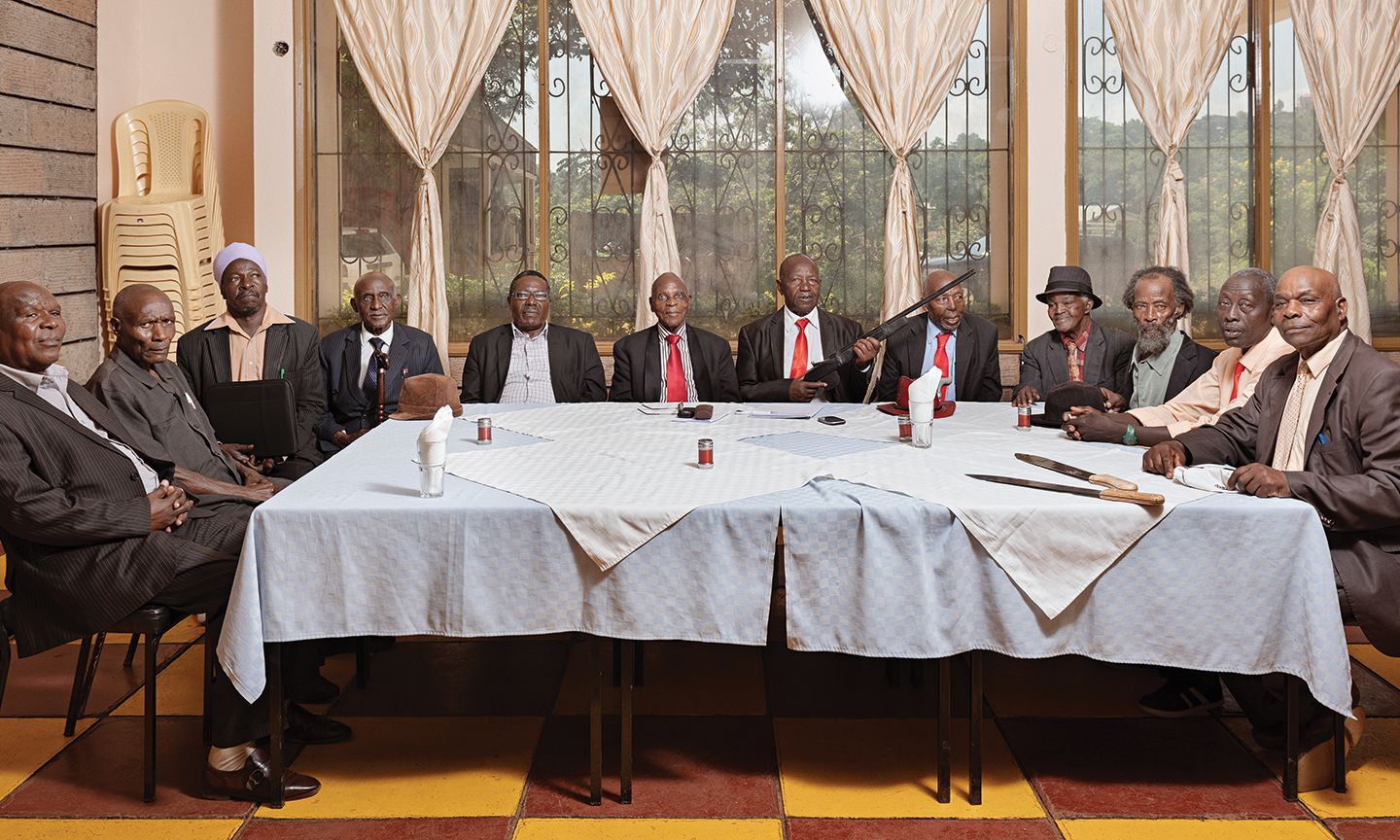The Mau Mau War Veterans Association, Murang’a, Kenya (2019), from the series State of Emergency – Harakati za Mau Mau kwa Haki, Usawa na Ardhi Yetu, by Max Pinckers/MMWVA © Max Pinckers/MMWVA
“Dear Max Pinckers and Associates,” begins the letter, headed “Proposal For A Collaboration” and sent on 27 August 2017. “As Chairman of the Mau Mau War Veterans Association (Murang’a Branch), I take this opportunity to officially welcome you to our country.” Over the next few paragraphs, the letter sets out the hopes of survivors of the fight for independence in Kenya in the 1950s, and their desire to address atrocities committed by colonial forces. “You will get to hear the truth as opposed to the lies and negative propaganda the British spread across Europe. How they sold falsehoods to their own people, while hiding the vicious, racist, hatred, unjust and brutal occupation of our ancestral land, turning us into slaves and labourers. They robbed us by force of a gun.”
And so began an unlikely collaboration, a visual investigation into a contested history undertaken by the young Belgian artist Max Pinckers and the last living members of a rebel army and their descendants. It concerns the so-called Mau Mau uprising and its brutal suppression during the last years of British colonial rule. And it is not one story but many, pitting the personal accounts of surviving veterans of the rebel Kenya Land and Freedom Army (the “Mau Mau”), alongside images of the remnants of the war and its containment, and copious archive materials that include hidden documents smuggled out by departing colonial powers. Published this month as an artist’s book, State of Emergency, it also considers the role of documentary storytelling and official record within the context of ongoing litigation and continued calls for reparations.
Few doubt that tens of thousands of people were killed in the crushing of the rebellion. And it is a matter of record that 1,090 prisoners were executed. Torture, rape, mass internment and collective punishment were used as instruments of suppression. But the specifics are still a matter of conjecture, not least because of a concerted attempt to bury the proof. However, a decade ago, the UK government came to an out-of-court settlement with some of the veterans and their families, awarding £19.9m in compensation, and a monument in Nairobi memorialising the victims of torture was erected. There was, however, a denial of liability, and for many Kenyans, the history remains an open wound.
Through testimonies from people who were there, and re-enactments of scenes from their fight for independence, Pinckers’s work “attempts to shine a light on this history’s blind spots by creating new ‘imagined records’ that fill in the missing gaps of historical archives”, he says.
The 36-year-old photographer had first visited East Africa a couple of years earlier. He travelled there out of a sense of curiosity after discovering a folder of British propaganda material about the Mau Mau while delving into the Archive of Modern Conflict, a vast private collection of vernacular photography and ephemera in London.
“The Mau Mau were painted in the classic propagandistic way as terrorists and savages,” Pinckers says. “And that got me interested because in my work I’m always interested in how images give a skewed or untruthful representation of something.” On his first travels in Kenya, he discovered a very different story. “The Mau Mau are the freedom fighters who brought independence to the country,” he says. “It’s the classic terrorist versus freedom fighter narrative.”
Pinckers met Mau Mau veterans, showing them copies of the archive documents he discovered in the UK, and he worked with some of them, alongside staff from Kenyan heritage organisations, to document historical sites from the era, such as mass graves and detention camps. But it was not until later, back in Belgium, that he got the idea of how to transcribe the veterans memories to fill those missing gaps. “A lot of the elderly veterans have walking sticks, and they will often pull them up and pretend it was a rifle or something” to demonstrate a scene, Pinckers says. “And I found that a very interesting way of showing this undocumented history, especially from those people who had actually experienced it personally, kind of redoing it.”
With the “Proposal For A Collaboration” agreed, Pinckers went back to Kenya with a new sense of purpose, returning with hundreds of copies of recently released materials from the national archives in the UK. These are known as the Hanslope Disclosure, a secret stash of colonial-era documents from 37 former British territories that was discovered in 2011 and released to the public the following year. “And based on that, the veterans organised themselves to come up with scenes that they wanted to photograph,” Pinckers says. “We see those pictures, accompanied by all the places that have been photographed and all the archival material—the collective project as a whole—as a kind of answer to an archive that’s very fragmented and full of holes … a bit of a dirty secret.”
Pinckers says that while making State of Emergency, he came to realise that “our audience is primarily British, and in a larger sense a European audience, as colonialism was a European enterprise. We don’t believe in a naive sense that the project is going to fix everything. The most we can hope for is that it’s a reminder, a gesture, to say, ‘Look, there’s still so much unresolved, let’s talk about it.’”

